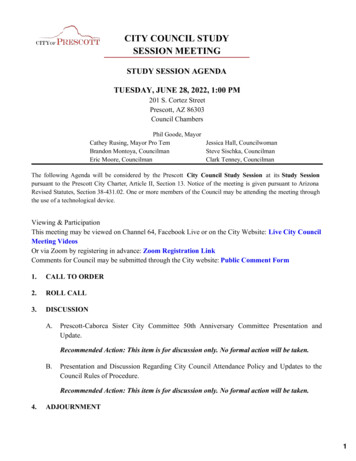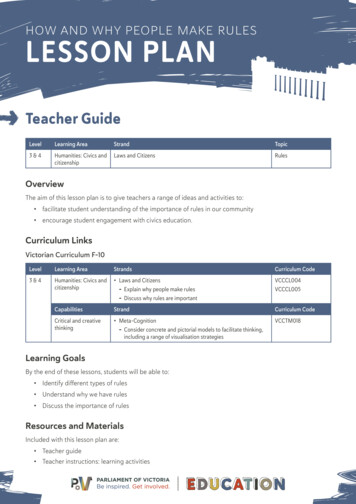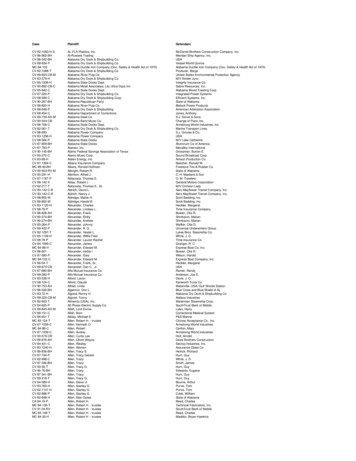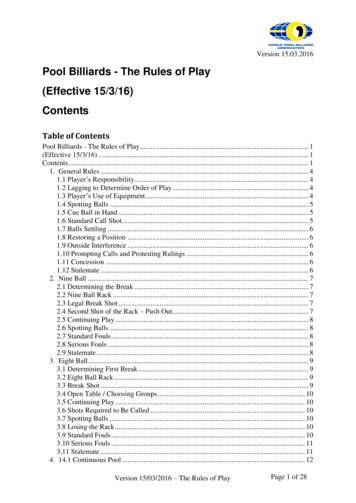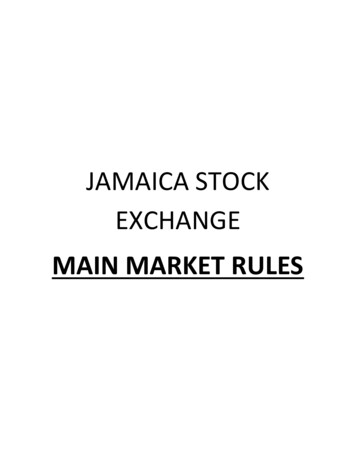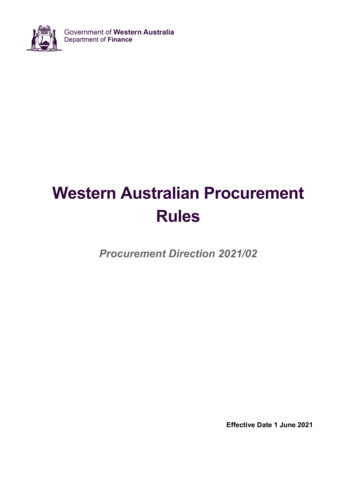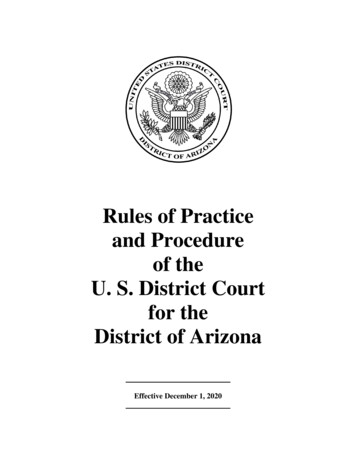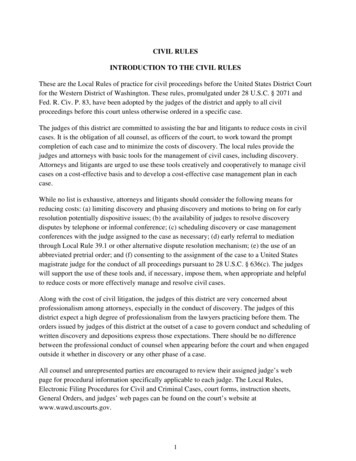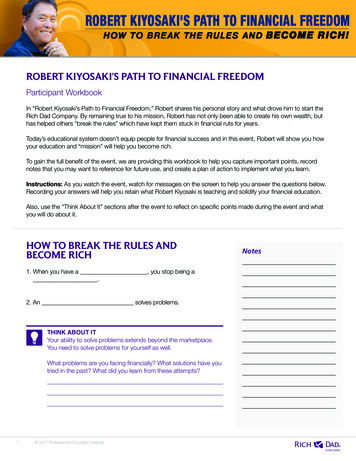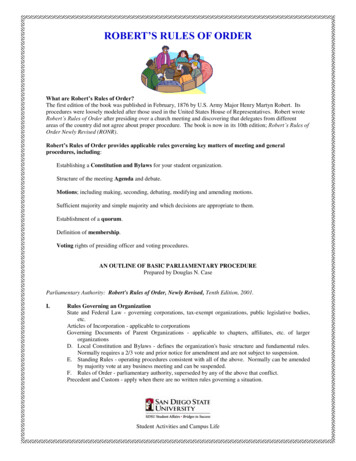
Transcription
ROBERT’S RULES OF ORDERWhat are Robert’s Rules of Order?The first edition of the book was published in February, 1876 by U.S. Army Major Henry Martyn Robert. Itsprocedures were loosely modeled after those used in the United States House of Representatives. Robert wroteRobert’s Rules of Order after presiding over a church meeting and discovering that delegates from differentareas of the country did not agree about proper procedure. The book is now in its 10th edition; Robert’s Rules ofOrder Newly Revised (RONR).Robert’s Rules of Order provides applicable rules governing key matters of meeting and generalprocedures, including:Establishing a Constitution and Bylaws for your student organization.Structure of the meeting Agenda and debate.Motions; including making, seconding, debating, modifying and amending motions.Sufficient majority and simple majority and which decisions are appropriate to them.Establishment of a quorum.Definition of membership.Voting rights of presiding officer and voting procedures.AN OUTLINE OF BASIC PARLIAMENTARY PROCEDUREPrepared by Douglas N. CaseParliamentary Authority: Robert's Rules of Order, Newly Revised, Tenth Edition, 2001.I.Rules Governing an OrganizationState and Federal Law - governing corporations, tax-exempt organizations, public legislative bodies,etc.Articles of Incorporation - applicable to corporationsGoverning Documents of Parent Organizations - applicable to chapters, affiliates, etc. of largerorganizationsD. Local Constitution and Bylaws - defines the organization's basic structure and fundamental rules.Normally requires a 2/3 vote and prior notice for amendment and are not subject to suspension.E. Standing Rules - operating procedures consistent with all of the above. Normally can be amendedby majority vote at any business meeting and can be suspended.F. Rules of Order - parliamentary authority, superseded by any of the above that conflict.Precedent and Custom - apply when there are no written rules governing a situation.Student Activities and Campus Life
II.Purposes of Parliamentary ProcedureEnsure majority ruleProtect the rights of the minority, the absentees and individual membersProvide order, fairness and decorumFacilitate the transaction of business and expedite meetingsIII.Basic Principles of Parliamentary ProcedureAll members have equal rights, privileges and obligations.A quorum must be present for the group to act – if the bylaws of the organization do not establish aquorum, the general rule is that a majority of the entire membership must be present in order totransact business.Full and free discussion of every motion is a basic right.Only one question at a time may be considered, and only one person may have the floor at any onetime.Members have a right to know what the immediately pending question is and to have it restated before avote is taken.No person can speak until recognized by the chair.Personal remarks are always out of order.A majority decides a question except when basic rights of members are involved.A two-thirds vote is required for any motion that deprives a member of rights in any way (e.g., cuttingoff debate).Silence gives consent. Those who do not vote allow the decision to be made by those who do vote.The chair should always remain impartial.IV.Typical Order of BusinessA.Call to OrderB.Opening Exercises, if applicableC.Roll Call/Determination of a QuorumD.Adoption of the AgendaE.Reading and Approval of the Minutes of the Previous MeetingF.Reports of OfficersG.Reports of Standing CommitteesH.Reports of Special (Ad hoc) CommitteesI.Special OrdersJ.Unfinished Business and General OrdersK.New BusinessL.Program, if applicableM.AnnouncementsN."Good of the Order"O.AdjournmentV.Role of the Presiding OfficerA.Remain impartial during debate - the presiding officer must relinquish the chair in order todebate the merits of a motionB.Vote only to create or break a tie (or 2/3 for matters requiring a 2/3 vote) – exception: thepresiding officer may vote on any vote by ballotC.Determine that a quorum is present before transacting businessD.Introduce business in proper orderE.Recognize speakersF.Determine if a motion is in orderG.Keep discussion germane to the pending motionH.Maintain orderI.Put motions to a vote and announce resultsJ.Employ unanimous consent (general consent) when appropriateVI.General Procedure for Handling a MotionA.A member normally must obtain the floor by being recognized by the chair.B.Member makes a motion.C.A motion must normally be seconded by another member before it can be considered.
Before the motion is restated by the chair, any member can rise, without waiting to be recognized, andsuggest a modification of the wording to clarify the motion. The maker of the motion can chooseto accept or reject the modified wording (does not require a second).If the motion is in order, the chair will restate the motion and open debate (if the motion is debatable).The maker of a motion has the right to speak first in debate.Debate is closed when:1. Discussion has ended, or2. A two-thirds vote closes debate ("Previous Question")H.The chair restates the motion, and if necessary clarifies the consequences of affirmative andnegative votes.I.The chair calls for a vote.J.The chair announces the result.K.Any member may challenge the chair's count by demanding a “Division of the Assembly.”VII.General Rules of DebateA.No members may speak until recognized by the chair.B.All discussion must be relevant to the immediately pending question.C.No member may speak a second time until every member who wishes to speak has had theopportunity to do so.D.No member can speak more than twice to each motion.E.No member can speak more than ten minutes.F.All remarks must be addressed to the chair – no cross debate is permitted.G.It is not permissible to speak against one’s own motion (but one can vote against one's ownmotion).H.Debate must address issues not personalities – no one is permitted to make personal attacks orquestion the motives of other speakers.I.The presiding officer must relinquish the chair in order to participate in debate and cannotreassume the chair until the pending main question is disposed of.J.When possible, the chair should let the floor alternate between those speaking in support andthose speaking in opposition to the motion.K.When a large number of people wish to speak to a motion it may be advisable for the chair tomake a speakers' list.L.Members may not disrupt the assembly.M.Rules of debate can be changed by a two-thirds vote.VIII.Motions in Ascending Order of PrecedenceOnly one main motion may be on the floor at a time, but more than one secondary motion may be on thefloor. When any of the motions on the following list is the immediately pending motion (i.e., the lastmotion made), any motion listed below it on the list can be made at that time and any motion above iton the list cannot be made at that time. Pending motions must be disposed of in descending order ofprecedence.A.Main Motion - introduces business to the assembly for its consideration. A main motion canonly be made when no other motion is pending. A main motion yields to privileged, subsidiaryand incidental motions.B.Subsidiary Motions - change or affect how the main motion is handled (voted on before themain motion)1.Postpone Indefinitely - made when the assembly does not want to take a position on themain question. Its adoption kills the main motion for the duration of the session andavoids a direct vote on the question. It is useful in disposing of a poor motion that cannotbe either adopted or expressly rejected without possibly undesirable consequences.Unlike other subsidiary motions, debate on the motion to postpone indefinitely can go intothe merits of the main motion.2.Amend - changes the wording of the main motion before it is voted upon. An amendmentmust be germane to the main motion. Its acceptance does not adopt the motion therebyamended; that motion remains pending in its modified form. Rejection of an amendmentleaves the pending motion worded as it was before the amendment was offered. Anamendment can: delete words, phrases, sentences or paragraphs; strike out words, phrasesor sentences and insert new ones; add words, phases, sentences or paragraphs; orsubstitute entire paragraph(s) or the entire text of the motion and insert another.When an entire motion is substituted for another, the chair must first call for a vote on the
Motion to Substitute to determine the advisability of substituting a new motion. If theMotion to Substitute passes, the chair then throws the Substitute Motion open to debate.The Substitute Motion in turn must be voted upon, and is subject to amendment. Note:There is no provision in Robert's Rules for a “Friendly Amendment.” The only way amotion can be modified without a vote, after it has been stated by the Chair, is with theunanimous consent of the members present.3.C.IX.Secondary Amendment - An amendment can be offered to an amendment (amendmentof the second order). Amendments of the third order are not permitted.4.Refer (Commit) - sends a pending motion to a standing committee, or to an ad hoc(special) committee to be appointed or elected, for consideration. The motion to refer mayinclude instructions to investigate, recommend, or take action, and may specify thecomposition of the committee.5.Postpone Definitely (Postpone to a Certain Time) - delays action until a certain timespecified in the motion (not beyond the next regular business meeting).6.Limit or Extend Debate - is used (1) to reduce or increase the number or length ofspeeches permitted or (2) to require that debate be closed at a specified time. It requires atwo-thirds vote.7.Previous Question (“Call for the Question”) - immediately closes debate if passed.Requires a second and a two-thirds vote.8.Lay on the Table - enables the assembly to lay the pending question aside temporarilywhen something else of immediate urgency has arisen. It is not debatable. A motion to layon the table is out of order if the evident intent is to avoid further consideration of themotion. Frequently when one indicates a desire “to table” a motion, the correct motion iseither to Postpone Indefinitely or Postpone Definitely.Privileged Motions - do not relate to the pending business but have to deal with urgent matterswhich, without debate, must be considered immediately.1.Call for the Orders of the Day - requires the assembly to conform to the agenda or totake up a general or special order that is due to come up at the time (“time certain”), unlesstwo-thirds of those voting wish to do otherwise. A member can interrupt a speaker to callfor the orders of the day.2.Raise a Question of Privilege - permits a request or main motion relating to the rightsand privileges of the assembly or any of its members. Examples include requests relatingto members’ ability to hear a speaker or a request to go into “executive session” (closedsession). A member may interrupt a speaker to raise a question of privilege.3.Recess - used to request an intermission which does not close the meeting.4.Adjourn - used to close the meeting immediately. Not debatable.5.Fix the Time to Which to Adjourn - sets the time, and sometimes the place, for anothermeeting (“adjourned meeting”) before the next regular business meeting to continuebusiness of the session.Incidental Motions (Questions of procedure that arise out of other motions and must be consideredbefore the other motion)A.Point of Order - used when a member believes that the rules of the assembly are being violated,thereby calling on the chair for a ruling and enforcement of the rules. A member can interrupt aspeaker to raise a point of order.B.Appeal - used to challenge the chair’s ruling on a question of parliamentary procedure. Amember can interrupt a speaker to appeal from the decision of the chair.C.Suspend the Rules - used to make a parliamentary rule or special rule of an organizationtemporarily inoperative. The motion cannot be applied to the constitution and bylaws unlessthose documents include specific provisions for suspension. Normally requires a two-thirds vote.D.Withdraw - permits the maker of a motion to remove it from deliberation after the motion hasbeen stated by the chair. If there is not unanimous consent, the motion is debated and votedupon.E.Point of Information - requests to the chair, or through the chair to another officer or member,to provide information relevant to the business at hand. A point of information must be in theform of a question. A request for information regarding parliamentary procedure or theorganization's rules bearing on the business at hand is referred to as a Parliamentary Inquiry.F.Objection to the Consideration of a Question - suppresses business that is irrelevant orinappropriate and undesirable to be discussed. The objection must be made immediately
G.H.(acceptable to interrupt a speaker). Does not require a second, is not debatable, and requires atwo-thirds vote opposed to consideration in order to pass.Division of a Question - divides a motion containing two or more provisions that can standalone so that each provision can be considered and voted upon separately. Not debatable.Division of the Assembly - used to demand a rising vote to verify the vote count. The motioncan be made without obtaining the floor, does not require a second, is not debatable, and does notrequire a vote.X.Main Motions That Bring a Question Back Before the AssemblyA.Take from the Table - resumes consideration of a motion laid on the table earlier in the samesession or in the previous session. Not debatable.B.Reconsider - reopens a motion to debate that has already been voted upon in the same session.The motion to reconsider can only be made by a member who voted on the prevailing side. Itsuspends action on the motion to which it is applied until it has been decided. It cannot bepostponed beyond the next regular business session.C.Rescind (Annul or Repeal) or Amend Something Previously Adopted - repeals or amends amotion for which it is too late to reconsider. Normally requires a two-thirds vote of those presentor a majority vote or the entire membership; however, if previous notice has been given thenonly a majority vote of those present is required. A motion to rescind cannot be applied to actionthat cannot be reversed.XI.VotingA.Majority vote - defined as more than half of the votes cast by those present and voting (i.e.,excluding abstentions) unless the organization’s rules specify otherwise (e.g., majority of thosepresent, or majority of the entire membership)B.Two-thirds vote - defined as at least two-thirds of those present and voting, unless otherwisespecified by the organization’s rules. Examples of motions that require a two-thirds vote: toclose, limit, or extend debate; to suspend the rules; to amend the constitution and bylaws; to closenominations; to remove an officer or expel a member; or to object to the consideration of amotion.C.Voting by the Chair - except when there is a ballot vote, the chair only votes when his/her votewould affect the result.D.Methods of Voting1.Voice vote - method normally used2.Show of hands or rising vote - used to verify an inconclusive voice vote or on motionsrequiring a two-thirds vote3.Ballot - normally used for election of officers and when ordered by a majority vote4.Roll call vote - used when it is desired to have a record of how each member voted. Canbe ordered by a majority vote unless the organization’s bylaws specify otherwise.E.Proxy voting is prohibited unless specifically provided for in the charter or bylaws.Recommended BooksRobert’s Rules of Order, Newly Revised, Tenth Edition, 2000Robert’s Rules of Order, Newly Revised, In Brief, 2004The Complete Idiot’s Guide to Robert’s Rules, Nancy Sylvester, 2004Robert’s Rules for Dummies, C. Alan Jennings, 2004Recommended Web ulesonline.comwww.parlipro.org
Motion to Substitute to determine the advisability of substituting a new motion. If the Motion to Substitute passes, the chair then throws the Substitute Motion open to debate. The Substitute Motion in turn must be voted upon, and is subject to amendment.Note: There is no provision in Robert's Rules for a "Friendly Amendment." The only way a
